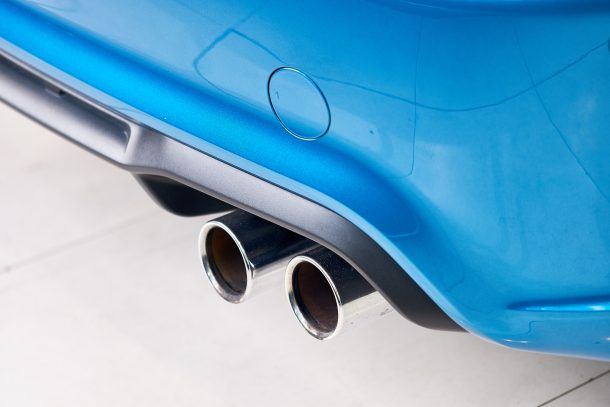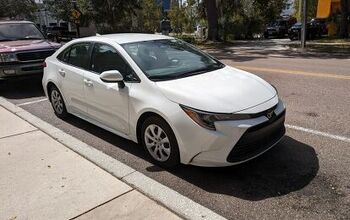Vellum Venom Vignette: Turn Down (Exhaust Tips) For What?

Jeff writes:
Sajeev:
I have a question that I don’t believe you have answered before in your talking about design features, and that is the weird obsession car makers have with exhaust outlets.
I really like driving big iron that can get out of its own way “with haste.” One of my favorite and much missed cars (except for the repair bills) was my BMW E38 750iL. This car was a great sleeper; big and fast, it didn’t need to shout for attention. One of the ways that it did this was by having a rear valence that completely wrapped around the back side of the car. No shouty exhausts on this Bavarian beast!
Fast forward to today: my daily driver is a ’00 Jaguar Vanden Plas Super V8 (Nice ride! — SM). It has dual exhausts with bigger outlets than the standard XJ8, though I bet the actual exhaust tubing isn’t any bigger compared to the regular V8s. Every big car that I have looked at recently has big protruding tips at the end of the exhaust. Mercedes-Benz S600/S65 AMG/S55 AMG, Audi S8, and even the Jaguar XJ Supercharged cannot provide simple turndowns.
Is there a technical reason for this, or does everyone feel that they just need to have big tubes out back?
Sajeev answers:
From a (Piston Slap) engineering standpoint? Turn down exhaust tips shall flow the CFMs worthy of today’s turbo luxo-sedans. And perhaps the real estate freed up allows for a deeper rear valance with better aerodynamics. Or not, but I digress …
The aforementioned turbo-barges do generate extra heat, adding extra sensitivity to restrictive muffler designs, exhaust bends and diameters, but all vehicles cool exhaust gases significantly between the front manifold and the rear bumper. With cooler exhaust temperatures comes a smaller, denser product, therefore something as minor as a turn down on a constant diameter pipe changes nothing.
I reckon smaller diameter rear pipes are within the realm of possibility until a certain horsepower threshold. And here’s my proof: this modified GT-R uses the flashy stock pipes as a design feature, but there’s a legit exhaust turn down to get the job done:
How many cars on the market today make power like this bad-boy? Riddle me that, Son.
From a Vellum Venom design standpoint? Every industrial designer, be it product or transportation, was exposed to these dilemmas as a youth. Product guys (and gals) likely sing the praises of stuff like the iconic Coke Bottle over aluminum cans, and transportation design peeps remember the design intricacies of whips from their childhoods. My love of 1987-93 Fox Body Mustangs is no different.
The LX 5.0 — the more appealing/valuable design today (especially the lighter 2-door Sedan) — had looooong chrome tailpipes, one of the few differentiators from the similarly clean look of the LX 2.3. The pipes added purpose without altering the LX’s nerdy Ford Fairmont DNA relative to macho Supras, F-bodies, DSMs, and others flaunting their bespoke sports coupe platforms.
But the Mustang GT? Peep the drop-jaw front bumper (awesome), side skirts emblazoned with the “Mustang GT” logo (meh) and fake scoops aplenty (yuck). But the cake’s icing was that deep-skirted rear valance with that GT logo and hidden, turned-down exhaust tips. It looked modern and upscale(-ish) for the changing, diversifying late-’80s performance car scene. The invisible tailpipes were part of the curb appeal.
The invisible LX 5.0 and the boisterous GT were equally appealing in my Fox Body-centric childhood. And today, it doesn’t matter if a new car is more LX 5.0 than GT in the rear: both designs are right.
[Images: Shutterstock user KULLAPONG PARCHERAT]

More by Sajeev Mehta
Latest Car Reviews
Read moreLatest Product Reviews
Read moreRecent Comments
- JMII I did them on my C7 because somehow GM managed to build LED markers that fail after only 6 years. These are brighter then OEM despite the smoke tint look.I got them here: https://www.corvettepartsandaccessories.com/products/c7-corvette-oracle-concept-sidemarker-set?variant=1401801736202
- 28-Cars-Later Why RHO? Were Gamma and Epsilon already taken?
- 28-Cars-Later "The VF 8 has struggled to break ground in the increasingly crowded EV market, as spotty reviews have highlighted deficiencies with its tech, ride quality, and driver assistance features. That said, the price isn’t terrible by current EV standards, starting at $47,200 with leases at $429 monthly." In a not so surprising turn of events, VinFast US has already gone bankrupt.
- 28-Cars-Later "Farley expressed his belief that Ford would figure things out in the next few years."Ford death watch starts now.
- JMII My wife's next car will be an EV. As long as it costs under $42k that is totally within our budget. The average cost of a new ICE car is... (checks interwebs) = $47k. So EVs are already in the "affordable" range for today's new car buyers.We already have two other ICE vehicles one of which has a 6.2l V8 with a manual. This way we can have our cake and eat it too. If your a one vehicle household I can see why an EV, no matter the cost, may not work in that situation. But if you have two vehicles one can easily be an EV.My brother has an EV (Tesla Model Y) along with two ICE Porsche's (one is a dedicated track car) and his high school age daughters share an EV (Bolt). I fully assume his daughters will never drive an ICE vehicle. Just like they have never watched anything but HiDef TV, never used a land-line, nor been without an iPad. To them the concept of an ICE power vehicle is complete ridiculous - you mean you have to STOP driving to put some gas in and then PAY for it!!! Why? the car should already charged and the cost is covered by just paying the monthly electric bill.So the way I see it the EV problem will solve itself, once all the boomers die off. Myself as part of Gen X / MTV Generation will have drive a mix of EV and ICE.


































Comments
Join the conversation
The Fox body Mustang LX looks great with the chrome pipes but the GT looks nice and clean with the rear skirt and hidden pipes. The chopped out holes with tips as shown above just look cheap. An afternoon at Pep Boys with a hole saw.
I miss side-pipes. http://www.spiralturbobaffles.com/images/corvette/istockphoto_278208-corvette-side-pipes.jpg